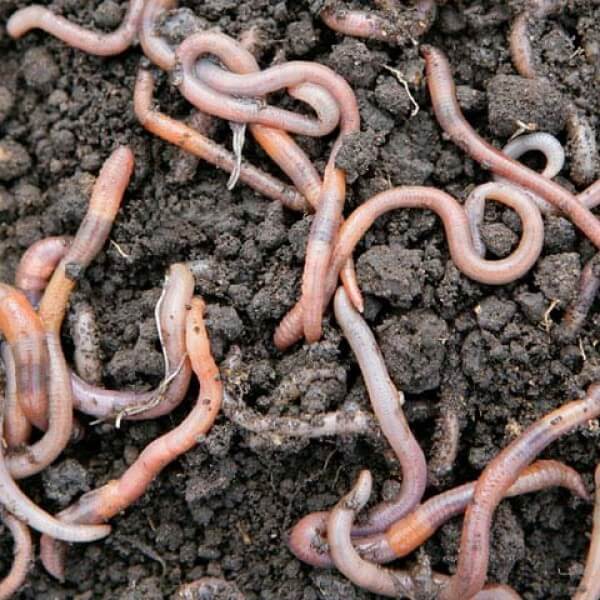In your garden, you can look around and easily see life: a bird singing, a beautiful flower, a ripening tomato. Life abounds, and it doesn't require a magnifying glass to see. Or does it?
In the soil beneath your feet, there's an invisible world filled with life-and-death drama. Scientists call this world the soil food web. This web features a diversity of creatures, from microscopic bacteria, fungi, and algae, to mites and nematodes, to earthworms, ants, spiders, and plant roots.
These organisms spend at least part of their lives in soil, enriching and enhancing it as they live their daily lives. Some soil food web members decompose organic matter, such as plant debris or manure. Others convert nitrogen, a basic plant nutrient, into forms plants can readily use. When you apply fertilizer, the soil food web makes that fertilizer available to plant roots. When too much nitrogen is present, the soil food web can hold much of that nitrogen in soil in forms that aren't readily available to plants, providing a microscopic fertilizer storage facility.
When the soil food web is healthy and active, it changes soil structure. These changes create soil that can hold water and allow air to penetrate to plant roots. Some members of the soil food web also break down pollutants that make their way into soil.
Soil food web components live throughout soil, but they're typically concentrated where organic matter is—usually in the top few inches of soil around the tips of plant roots. Roots release proteins and sugars, which feed bacteria in the soil. Other creatures, nematodes and protozoa, feed on the bacteria. This part of the soil food web that takes place near plant roots actually helps feed plants and strengthens them to resist disease.
One easy way to add organic matter to your garden is to mix Miracle-Gro® Performance Organics® All Purpose In-Ground Soil, which is enriched with aged compost, in with the top layer of soil.


There's a Fungus Among Us!
Several different types of organisms make up the soil food web. Bacteria don't move far in soil and tend to digest green matter. Fungi, on the other hand, migrate in the soil. As fungi grow, they create threads that are thousandths of an inch thick. These threads extend through soil, creating channels for water and air. When threads bind together to form a large mass, they increase the soil's ability to hold water. Some fungi are decomposers, breaking down brown, coarse organic material into forms that other soil organisms can use. This action enhances soil with humic acid-rich organic matter, which resists breakdown and helps soil retain water.
Mycorrhizal fungi grow around or in plant roots, drawing carbon and sugars from the plant and pumping various nutrients and water directly into plant roots. The result is that plants with mycorrhizal colonies grow faster, bigger, and stand up to stress better. Mycorrhizal fungi form specific partnerships with plants, so that there are particular fungi that colonize specific tree, vegetable, or perennial roots. You can buy mycorrhizal fungi in a dry form to mix into soil to increase plant growth and productivity. Typically you add the fungi to planting holes. It is an easy way to jump-start your garden's soil food web and improve soil health. It'll be 4 to 6 weeks before you'll see results in plant growth.
Creatures in Your Soil
Protozoa are single-celled organisms that eat bacteria. As protozoa digest bacteria, the process releases nitrogen in a form plants can use. Nematodes are non-segmented worms that feast on plants, algae, bacteria, fungi, and other nematodes. Their role in the soil food web enriches soil and helps control disease organisms. (These are not the same as root-knot nematodes, which feed on plant roots.)
Another group of soil creatures, arthropods, includes many insects or close relatives such as tiny invisible mites, springtails, and bigger, easily visible centipedes, spiders, beetles, and millipedes. They shred organic matter in soil so good bacteria can break it down so it releases nutrients for roots to absorb. These bacteria, which don't move far in soil, tend to attach to insects and other related creatures that are highly mobile and often transport bacteria to their food source.
As arthropods feed on organic matter, they make almost invisible little pellets of poop that enrich soil. Arthropods also compete with disease organisms for food. For instance, some disease organisms feed on plant roots. When arthropods are present, they prey upon those disease organisms, devouring them before they can infect roots.
Earthworms break down organic matter in soil. As organic matter passes through a worm's gut, it's enriched with nutrients and minerals. Worm poop, or castings, is sold as a rich fertilizer. When earthworms are active, they increase soil's ability to hold water, create channels for roots to grow in, and increase microorganism concentrations in soil.




 Herbs
Herbs
 Vegetables
Vegetables
 Fruit
Fruit
 Flowers
Flowers
 Succulents
Succulents


